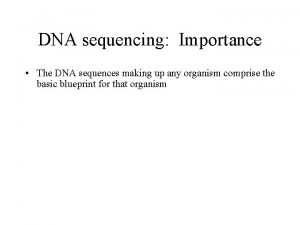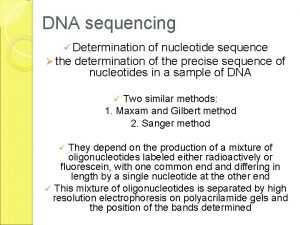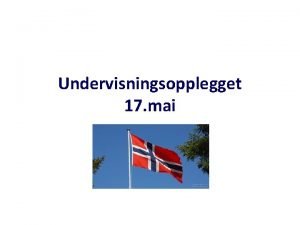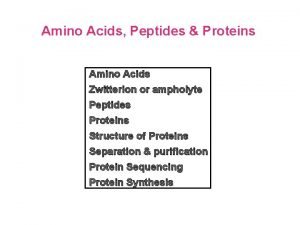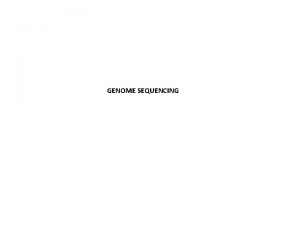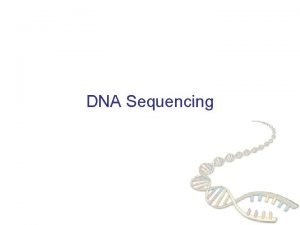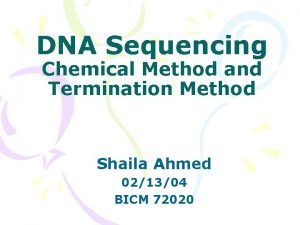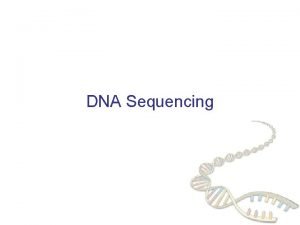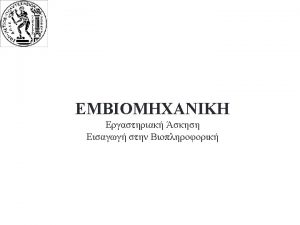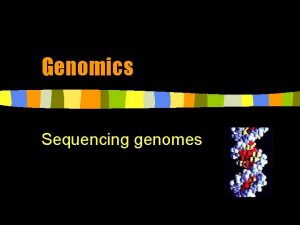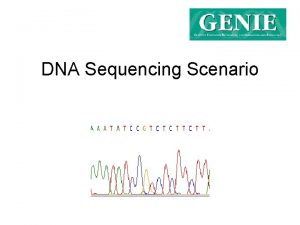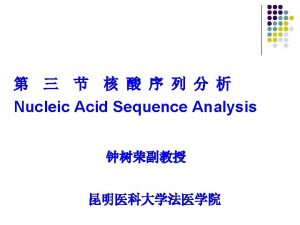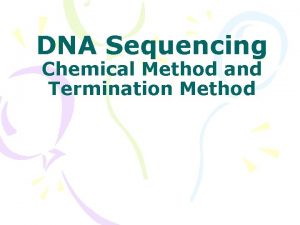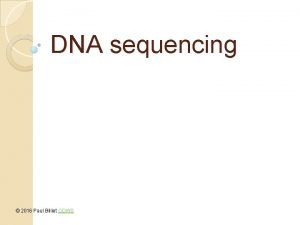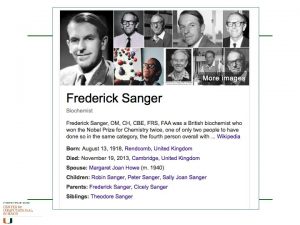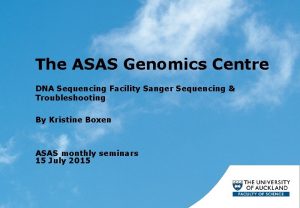DNA SEQUENCING IRSHAD Chain termination Sanger DNA sequencing













- Slides: 13

DNA SEQUENCING IRSHAD.

Chain termination (Sanger) DNA sequencing � Chain termination DNA sequencing is based on the principle that single -stranded DNA molecules that differ in length by just a single nucleotide can be separated from one another by polyacrylamide gel electrophoresis. � This means that it is possible to resolve a family of molecules, representing all lengths from 10 to 1000 nucleotides. � The starting material for a chain termination sequencing experiment is a preparation of identical single-stranded DNA molecules. � The first step is to anneal a short oligonucleotide to the same position on each molecule, this oligonucleotide subsequently acting as the primer for synthesis of a new DNA strand that is complementary to the template.


� The strand synthesis reaction, which is catalyzed by a DNA polymerase enzyme and requires the four deoxyribonucleotide triphosphates (d. NTPs—d. ATP, d. CTP, d. GTP, and d. TTP) as substrates, would normally continue until several thousand nucleotides had been polymerized. � This does not occur in a chain termination sequencing experiment because, as well as the four deoxynucleotides, a small amount of each of four dideoxynucleotides (dd. NTPs—dd. ATP, dd. CTP, dd. GTP, and dd. TTP) is added to the reaction. � Each of these dideoxynucleotides is labeled with a different fluorescent marker.

� The polymerase enzyme does not discriminate between deoxy- and dideoxynucleotides, but once incorporated a dideoxynucleotide blocks further elongation because it lacks the 3′-hydroxyl group needed to form a connection with the next nucleotide � Because the normal deoxynucleotides are also present, in larger amounts than the dideoxynucleotides, the strand synthesis does not always terminate close to the primer: in fact, several hundred nucleotides may be polymerized before a dideoxynucleotide is eventually incorporated. � The result is a set of new molecules, all of different lengths, and each ending in a dideoxynucleotide whose identity indicates the nucleotide —A, C, G, or T—that is present at the equivalent position in the template DNA


� To work out the DNA sequence, all that we have to do is identify the dideoxynucleotide at the end of each chain-terminated molecule. � This is where the polyacrylamide gel comes into play. � The mixture is loaded into a well of a polyacrylamide slab gel, or into a tube of a capillary gel system, and electrophoresis carried out to separate the molecules according to their lengths. � After separation, the molecules are run past a fluorescent detector capable of discriminating the labels attached to the dideoxynucleotides. � The detector therefore determines if each molecule ends in an A, C, G, or T. � The sequence can be printed out for examination by the operator.


� Thermal cycle sequencing, is carried out in a similar way to PCR, but just one primer is used and the reaction mixture includes the four dideoxynucleotides. � Because there is only one primer, only one of the strands of the starting molecule is copied, and the product accumulates in a linear fashion, not exponentially as is the case in a real PCR. � The presence of the dideoxynucleotides in the reaction mixture causes chain termination, as in the standard methodology, and the family of resulting strands can be analyzed and the sequence read in the usual way. � Thermal cycle sequencing can therefore be used with DNA cloned in any type of vector.

The primer determines the region of the template DNA that will be sequenced � In the first stage of a chain termination sequencing experiment, an oligonucleotide primer is annealed onto the template DNA. � The main function of the primer is to provide the short double-stranded region that is needed in order for the DNA polymerase to initiate DNA synthesis. � The primer also plays a second critical role in determining the region of the template molecule that will be sequenced. � For most sequencing experiments a universal primer is used, this being one that is complementary to the part of the vector DNA immediately adjacent to the point into which new DNA is ligated. � The 3′ end of the primer points toward the inserted DNA, so the sequence that is obtained starts with a short stretch of the vector and then progresses into the cloned DNA fragment.

� If the DNA is cloned in a plasmid vector, then both forward and reverse universal primers can be used, enabling sequences to be obtained from both ends of the insert. � This is an advantage if the cloned DNA is more than 750 bp and hence too long to be sequenced completely in one experiment. � Alternatively, it is possible to extend the sequence in one direction by synthesizing a nonuniversal primer, designed to anneal at a position within the insert DNA


